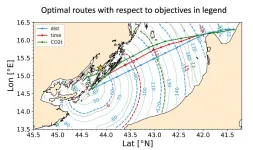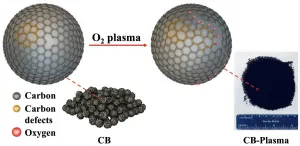(Press-News.org) Photoplethysmography (PPG) is a simple optical technique used to detect volumetric changes in peripheral blood circulation. It's used in smart watches, for example, to monitor pulse and heart rate, but PPG biosensors are also found in millions of smartphones, but without any current clinical applications.
In a study published online in the February 2021 issue of Chest, researchers at University of California San Diego School of Medicine, with industry collaborators, found that already embedded PPG in smartphones, in tandem with application software, could be used for remote clinical pulse oximetry to manage chronic cardiopulmonary disease and perhaps initial treatment and monitoring of persons affected in respiratory viral pandemics, such as COVID-19.
"Pulse oximetry monitoring plays an important role in managing pulmonary diseases, especially during pandemics or epidemics of respiratory viral infections, such as COVID-19 and influenza," said the study's first author Sara H. Browne, MD, an associate professor in the UC San Diego School of Medicine and an infectious disease specialist.
Oxygen saturation is a valuable component of the clinical evaluation used to differentiate those that require close monitoring. In circumstances of home quarantine, remote clinical pulse oximetry allows patients to objectively report oxygen saturation and heart rate in addition to their symptoms. Smartphone sensors with apps could facilitate access to these measurements, but to be utilized clinicians must know that these measurements are accurate and reliable.
Browne also noted there are health equity aspects in remote monitoring.
"Smartphones with sensors and apps could significantly enhance remote monitoring due to their ubiquity, and don't require patients to have additional expensive gadgets."
PPG sensors measure distention or enlargement of arteries and other vessels under the skin as blood pulses through them by detecting differences in light absorbed or reflected back to a pair of light-emitting diodes in the device. The painless, non-invasive technology is called pulse oximetry and is commonly used in hospitals and clinics, often to evaluate oxygen levels in patients' blood.
In their study, researchers recruited 10 volunteers (three Caucasian, three Black and four Asian), each placed an index finger over a smartphone sensor system with an app designed to clinically interpret the resulting optical data. The volunteers then breathed a mixture of gases with reduced levels of oxygen, sequentially declining to reach stable arterial oxygen saturations between 70 percent and 100 percent. They found that the smartphone measurements of blood-oxygen levels corresponded with other Food and Drug Administration-approved clinical tools used for this purpose.
Then, using the same smartphone, the researchers analyzed more than 2,200 readings taken simultaneously from smartphone pulse oximetry and in-hospital Welch-Allyn instruments in 320 study participants, ages 18 to 89, and representing a broad range of racial and ethnic backgrounds. They found that the smartphone readings had equivalent measurement accuracy and precision to the expensive FDA-approved hospital instruments.
INFORMATION:
The study authors said wide use data on at-home oxygen saturation levels, anonymized and broadly disseminated, might also be used by public health officials to assess disease prevalence in a community, and help direct clinical resources, such as hospital bed availability.
The authors urged more research on a larger scale, with eventual consideration of smartphone-based pulse oximetry becoming a new health care tool in the clinic and beyond.
Co-authors include: Senior author Florin Vaida, Samuel C. Pan and Jonathan Gonzalez Garcia, UC San Diego; Mike Bernstein, Physio Monitor, LLC; and Craig A. Easson and Chung-Che Huang, Maxim Integrated.
As governments try to mitigate the spread of COVID-19, many are turning to contact tracing, including apps that track your location and electronic check-in QR codes. But with that technology come questions of personal safety, privacy, trust, control and collective action. So what can be done to improve these large-scale technological system roll-outs without infringing on a citizen's right to privacy?
"These systems are logging your physical social network," said Katina Michael, an Arizona State University professor at the School for the Future of Innovation in Society in the College of Global Futures and the School of Computing, Informatics and Decision Systems Engineering in the Ira A. Fulton Schools of Engineering. "The physical has become more ...
Beyond the environmental benefits and lower electric bills, it turns out installing solar panels on your house actually benefits your whole community. Value estimations for grid-tied photovoltaic systems prove solar panels are beneficial for utility companies and consumers alike.
For years some utility companies have worried that solar panels drive up electric costs for people without panels. Joshua Pearce, Richard Witte Endowed Professor of Materials Science and Engineering and professor of electrical and computer engineering at Michigan Technological University, has shown the opposite is true -- grid-tied solar photovoltaic (PV) owners are actually subsidizing their non-PV ...
ALBUQUERQUE, N.M. -- The huge forces generated by the Z machine at Sandia National Laboratories are being used to replicate the gravitational pressures on so-called "super-Earths" to determine which might maintain atmospheres that could support life.
Astronomers believe that super-Earths -- collections of rocks up to eight times larger than Earth -- exist in the millions in our galaxy. "The question before us is whether any of these super planets are actually Earthlike, with active geological processes, atmospheres and magnetic fields," said Sandia physicist Joshua Townsend.
The current ...
Energy efficiency or carbon intensity (defined as CO2 emissions per transport work, ed.) is a possible point of convergence between the International Maritime Organization (IMO) and EU regulations to cut GHG emissions and decarbonize shipping. Short term measures to increase energy efficiency and achieve carbon intensity savings include voyage optimization.
A new study led by the CMCC Foundation, realized in the framework of the Interreg Italy-Croatia END ...
New research by Morgan Philbin, PhD, at Columbia University Mailman School of Public Health and colleagues looks at why Black young men who have sex with men (YMSM) are disproportionately subject to high rates of arrest and incarceration. They find that perceived racial discrimination, sexual orientation discrimination, and HIV-status discrimination are all associated with risk for criminal justice involvement in this population.
The research appears in the journal Stigma and Health.
Various studies have shown that Black men are imprisoned at nearly seven times the rate of white men; sexual minority young adults are nearly three times more likely to report being criminally sanctioned compared to their heterosexual ...
An electrocardiogram (ECG) is an examination that records the electrical activity of the heart during the cardiac cycle. It is non-invasive and usually involves placing electrodes on the subject's skin. It is a most indicated type of examination when there is suspected heart disease and also in routine preventive health check-ups.
The cardiac cycle entails the emptying of blood from the atria to the ventricles ("P" wave, red in the image), the contraction of the ventricles to propel blood to the different tissues and organs of the body ("QRS" wave, green in the image), and ...
ATLANTA--ProAgio, a drug developed by Georgia State University biology professor Zhi-Ren Liu and his team, is effective at treating pancreatic cancer and prolonging survival in mice, according to a study published in the journal Cellular and Molecular Gastroenterology and Hepatology.
A second study, published in the Journal of Experimental Medicine, shows the drug is also effective against triple-negative breast cancer, a fast-growing and hard-to-treat type of breast cancer that carries a poor prognosis.
ProAgio, created from a human protein, targets the cell surface receptor integrin αVβ?, which is expressed on cancer-associated fibroblasts. Fibroblasts are cells ...
HOUSTON - (Feb. 9, 2021) - Rice University researchers have created a "defective" catalyst that simplifies the generation of hydrogen peroxide from oxygen.
Rice scientists treated metal-free carbon black, the inexpensive, powdered product of petroleum production, with oxygen plasma. The process introduces defects and oxygen-containing groups into the structure of the carbon particles, exposing more surface area for interactions.
When used as a catalyst, the defective particles known as CB-Plasma reduce oxygen to hydrogen peroxide with 100% Faradaic efficiency, a measure of charge transfer in electrochemical reactions. The process shows promise to replace the complex anthraquinone-based production ...
With the COVID-19 pandemic entering its second year, the challenges faced both by individuals and nations remain substantial. While notable medical advancements in the treatment of COVID-19 have been made, a host of questions about how to live with it and how to work to end it remain active.
Carnegie Mellon University researchers David Rode and Paul Fischbeck explore these questions in a new article, "On ambiguity reduction and the role of decision analysis during the pandemic," published in a special issue of the journal END ...
Wintertime outbreaks of COVID-19 have been largely driven by whether people adhere to control measures such as mask wearing and social distancing, according to a study published Feb. 8 in Nature Communications by Princeton University researchers. Climate and population immunity are playing smaller roles during the current pandemic phase of the virus, the researchers found.
The researchers -- working in summer 2020 -- ran simulations of a wintertime coronavirus outbreak in New York City to identify key factors that would allow the virus to proliferate. They found that relaxing control measures in the summer months led to an outbreak in the winter regardless of climate factors.
"Our results implied that lax control measures -- and likely ...



